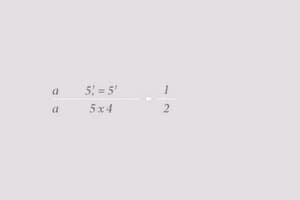Podcast
Questions and Answers
What is the limit of $\frac{\sqrt{x}}{x}$ as $x$ approaches infinity?
What is the limit of $\frac{\sqrt{x}}{x}$ as $x$ approaches infinity?
- Undefined
- ∞
- 0 (correct)
- 1
What happens to the limit of $ln(x)$ as $x$ approaches infinity?
What happens to the limit of $ln(x)$ as $x$ approaches infinity?
- -∞
- ∞ (correct)
- 1
- 0
For the function $\sin(x) - x$, what is the limit as $x$ approaches 0?
For the function $\sin(x) - x$, what is the limit as $x$ approaches 0?
- Undefined
- 0 (correct)
- 1
- -1
Which limit represents the indeterminate form $\infty - \infty$?
Which limit represents the indeterminate form $\infty - \infty$?
Applying L'Hôpital's Rule, what is the limit of $\frac{sin(x) - x}{x^3}$ as $x$ approaches 0?
Applying L'Hôpital's Rule, what is the limit of $\frac{sin(x) - x}{x^3}$ as $x$ approaches 0?
What is the behavior of the limit $\lim_{x\to 0} \frac{tan(x) - x}{x^3}$?
What is the behavior of the limit $\lim_{x\to 0} \frac{tan(x) - x}{x^3}$?
What is the limit of $\frac{x^2 + 3x + 5 - x}{x}$ as $x$ approaches infinity?
What is the limit of $\frac{x^2 + 3x + 5 - x}{x}$ as $x$ approaches infinity?
What is the limit of $\frac{1 - x^2}{x \cdot sin(x)}$ as $x$ approaches 0+?
What is the limit of $\frac{1 - x^2}{x \cdot sin(x)}$ as $x$ approaches 0+?
What is the maximum area of a rectangle that has its base on the x-axis and the remaining vertices on the curve defined by $y = 9 - x^2$?
What is the maximum area of a rectangle that has its base on the x-axis and the remaining vertices on the curve defined by $y = 9 - x^2$?
How far from the screen should a person stand to maximize the viewing angle when the lower edge of the screen is 5 feet and the upper edge is 20 feet above eye level?
How far from the screen should a person stand to maximize the viewing angle when the lower edge of the screen is 5 feet and the upper edge is 20 feet above eye level?
For the triangle formed by two wooden bars, rotated around hinge point O, what angle θ maximizes the area of triangle ABC?
For the triangle formed by two wooden bars, rotated around hinge point O, what angle θ maximizes the area of triangle ABC?
What is the height of a box with a width twice as long as the length, that maximizes volume given a surface area constraint of 400 cm²?
What is the height of a box with a width twice as long as the length, that maximizes volume given a surface area constraint of 400 cm²?
Which condition must be satisfied for the function $f(x) = \begin{cases} a & \text{if } x \leq 1 \ 12(\sqrt{x + 8 - b}) & \text{if } x > 1 \end{cases}$ to be continuous over $(-, \infty, \infty)$?
Which condition must be satisfied for the function $f(x) = \begin{cases} a & \text{if } x \leq 1 \ 12(\sqrt{x + 8 - b}) & \text{if } x > 1 \end{cases}$ to be continuous over $(-, \infty, \infty)$?
Which statement about differentiability at a point is true for the function $g(x) = \begin{cases} 4x & \text{if } x < 1 \ x^3 + 3 & \text{if } x \geq 1 \end{cases}$?
Which statement about differentiability at a point is true for the function $g(x) = \begin{cases} 4x & \text{if } x < 1 \ x^3 + 3 & \text{if } x \geq 1 \end{cases}$?
What can be inferred about the function described as one-to-one regarding its inverse function?
What can be inferred about the function described as one-to-one regarding its inverse function?
How many inflection points does the function y = f(x) = x^5 − 5x^4 + 25x have?
How many inflection points does the function y = f(x) = x^5 − 5x^4 + 25x have?
Which of the following represents the first derivative of the function f(x) = x^5 - 5x^4 + 25x?
Which of the following represents the first derivative of the function f(x) = x^5 - 5x^4 + 25x?
What is the purpose of the Mean Value Theorem in calculus?
What is the purpose of the Mean Value Theorem in calculus?
In sketching the graph of a function, what does the second derivative tell you?
In sketching the graph of a function, what does the second derivative tell you?
For the function f(x) = x^3 / (x - 16), what is the vertical asymptote?
For the function f(x) = x^3 / (x - 16), what is the vertical asymptote?
What values must be compared to find the absolute maximum and minimum of a function on a closed interval?
What values must be compared to find the absolute maximum and minimum of a function on a closed interval?
Which of the following correctly identifies a critical value for a function f?
Which of the following correctly identifies a critical value for a function f?
What type of asymptote does the function f(x) = (2x^3 - 4x^2 + 5x - 10) / (x^2 + x - 6) have, based on polynomial degrees?
What type of asymptote does the function f(x) = (2x^3 - 4x^2 + 5x - 10) / (x^2 + x - 6) have, based on polynomial degrees?
Flashcards
Maximum Area of a Rectangle
Maximum Area of a Rectangle
Finding the largest possible area of a rectangle whose base is on the x-axis, vertices lie on a parabola y = 9 - x^2, and the rectangle lies above the x-axis.
Viewing Angle Maximization
Viewing Angle Maximization
Calculating the optimal viewing distance from a screen to maximize the angle your eyes see of the screen.
Maximum Triangle Area
Maximum Triangle Area
Determining the biggest possible area of a triangle formed by two connecting rods, hinged at one point, and one rotating rod.
Rectangular Box Volume Maximization
Rectangular Box Volume Maximization
Signup and view all the flashcards
Inflection Point
Inflection Point
Signup and view all the flashcards
Continuity of a Function
Continuity of a Function
Signup and view all the flashcards
Differentiability of a Function
Differentiability of a Function
Signup and view all the flashcards
Local Extrema
Local Extrema
Signup and view all the flashcards
Continuous Function over (−∞, ∞)
Continuous Function over (−∞, ∞)
Signup and view all the flashcards
Critical Value
Critical Value
Signup and view all the flashcards
Absolute Maximum/Minimum
Absolute Maximum/Minimum
Signup and view all the flashcards
Inverse Function
Inverse Function
Signup and view all the flashcards
Mean Value Theorem
Mean Value Theorem
Signup and view all the flashcards
Concavity
Concavity
Signup and view all the flashcards
First Derivative Test
First Derivative Test
Signup and view all the flashcards
Asymptote
Asymptote
Signup and view all the flashcards
Limit using L'Hôpital's Rule
Limit using L'Hôpital's Rule
Signup and view all the flashcards
Indeterminate form 0/0
Indeterminate form 0/0
Signup and view all the flashcards
Indeterminate form ∞/∞
Indeterminate form ∞/∞
Signup and view all the flashcards
Indeterminate form ∞ × 0
Indeterminate form ∞ × 0
Signup and view all the flashcards
Indeterminate form ∞ − ∞
Indeterminate form ∞ − ∞
Signup and view all the flashcards
Limit of a Function at a Point
Limit of a Function at a Point
Signup and view all the flashcards
Limit as x approaches infinity
Limit as x approaches infinity
Signup and view all the flashcards
Trigonometric Limits
Trigonometric Limits
Signup and view all the flashcards
Study Notes
Final Exam Study Guide
- New Material Focus: Five questions on material since Exam 3, plus review of subject matter 14 (total distance).
Integrals and Riemann Sums
- Riemann Sum Approximation: Integrals can be approximated using Riemann sums. Employ the right endpoints of equal-width subintervals to determine the sum.
- Geometric Interpretation: Integrals can also be understood geometrically.
- Fundamental Theorem of Calculus (FTC): The FTC relates integrals to derivatives. Understanding the relationship between integration and differentiation is critical.
- Example Problems: Include the evaluation of definite integrals using the above methods and geometric interpretation
- Limits of sums: Use provided formulas to compute limits of sums
Computing Limits using Formulas
- Explicit Formulas: Use the provided equations to calculate specific limits.
Integration Techniques
- Substitution Rule: Use substitution to simplify integrals.
- Examples: Solve problems illustrating how to apply substitution methods in integration of definite and indefinite integrals.
Trigonometric Functions
- Double Angle Formulas: Familiarize yourself with double angle formulas for sine and cosine.
- Basic Trigonometric Identities: You will need understanding of pythagorean identities, sin2x + cos2x = 1 to solve problems related to trigonometric functions.
- Equations Involving Trigonometric Functions: You'll solve equations containing trigonometric functions, including finding the number of solutions on a specific interval (e.g., [0, 2π]).
Derivatives of Functions
- Derivative of a Product: Know how to differentiate functions of the form y = f(x)g(x)
- Examples: Solve problems finding derivatives of various function compositions, including trigonometric and logarithmic terms.
Related Rates Problems
- TWO Related Rates Problems: Expect two problems requiring understanding of rates of change of related quantities.
Optimization Problems
- Two Optimization Problems: Expect two problems focusing on maximizing or minimizing a quantity.
Continuity and Differentiability
- Continuity: Understand continuity.
- Differentiability: Understand differentiability and the difference between the two.
- Examples: Solve problems determining the continuity/differentiability of functions based on defined intervals.
Inverse Functions
- Inverse Function Formulas: Given a function and domain/range, you need to find the formula for the inverse function, and the range and domain of the inverse function.
- Graphs of Inverse Functions: Understand the relationship between the graph of a function and its inverse.
Implicit Differentiation
- Method of Implicit Differentiation: Understand how to use implicit differentiation, to compute derivatives and equations of tangent lines to curves.
Limits and L'Hôpital's Rule
- L'Hôpital's Rule: Use L'Hôpital's rule to evaluate limits of indeterminate forms.
- Calculating limits: Understand how to compute various limits.
- Limits of Indeterminate Forms: Master methods of calculating limits of indeterminate forms.
Absolute Maximum and Minimum Values
- Critical Values: Find critical values.
- Absolute Maximum and Minimum on Closed Intervals: Determine these values.
- Mean Value Theorem: Understand the statement and conditions for applying the Mean Value Theorem for derivatives and functions on closed intervals.
Position, Velocity & Acceleration
- Position Function: Relate the position function to velocity and acceleration.
- Interpreting velocity and acceleration: Understand the meaning of these concepts and how to determine when a given position function is speeding up or slowing down.
- Distance Traveled: Relate the concepts from previous sections to finding total distance traveled and understand the connection to integration.
Derivatives of composite functions / Chain rule
- Chain Rule:
- Examples: Solve problems highlighting the Chain Rule.
First and Second Derivatives Test
- First Derivative Test: Use this to classify critical points as local maximums or minimums.
- Second Derivative Test: Use this test alongside the first derivative test to find local extrema.
- Inflection Points: Understand how to identify inflection points
- Critical Points: Relate critical points to local maxima, local minima, and inflection points.
Additional
- Graphing Techniques: Skill in graphing functions using first and second derivatives. Recognize asymptotes, and understand concavity and increasing/decreasing patterns.
- Approximations: Master techniques for approximating values of functions (e.g., linear approximations).
Studying That Suits You
Use AI to generate personalized quizzes and flashcards to suit your learning preferences.





